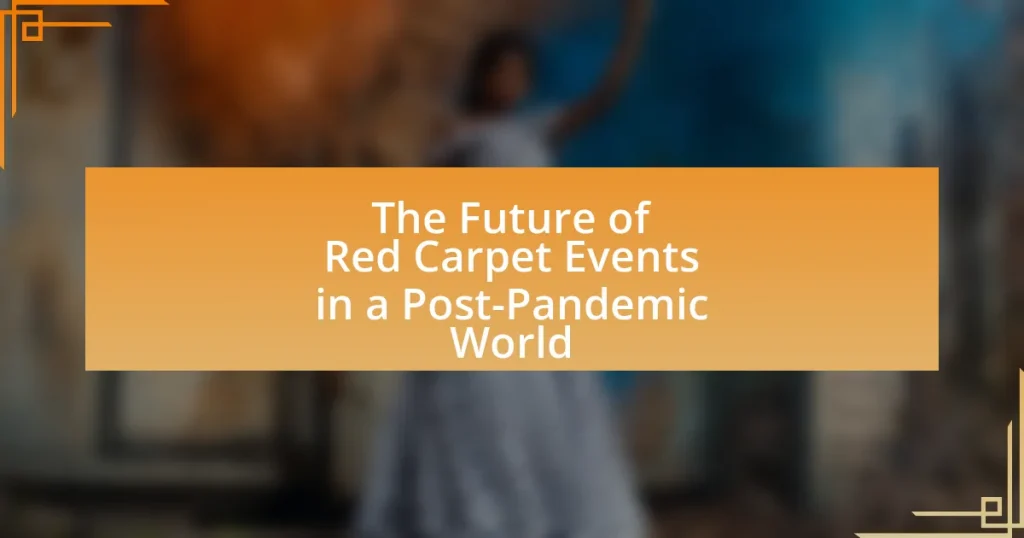Red carpet events are high-profile gatherings where celebrities showcase their fashion while promoting films, television shows, or charitable causes. These events have evolved from their historical origins to become significant cultural phenomena, influencing fashion trends and public perceptions of the entertainment industry. The COVID-19 pandemic has prompted substantial changes in red carpet formats, leading to the adoption of virtual and hybrid models, enhanced safety protocols, and a focus on sustainability. This article explores the future of red carpet events, examining the impact of technological innovations, audience engagement strategies, and the importance of inclusivity in a post-pandemic world.

What are Red Carpet Events and Their Significance?
Red carpet events are high-profile gatherings where celebrities and public figures showcase their fashion and style while promoting films, television shows, or charitable causes. These events hold significant cultural importance as they serve as a platform for media coverage, influencing fashion trends and public perceptions of the entertainment industry. Historically, red carpet events have been associated with major award ceremonies, such as the Oscars and the Golden Globes, where the glamour and spectacle attract global attention, thereby enhancing the visibility of the projects and individuals involved. The significance of these events extends beyond mere entertainment; they contribute to the branding of films and personalities, impacting box office performance and public engagement.
How have Red Carpet Events evolved over time?
Red carpet events have evolved significantly from their origins in ancient Greece, where they were used to welcome dignitaries, to the modern-day spectacles that celebrate film and fashion. Initially, red carpets served a practical purpose, providing a path for honored guests, but by the 1920s, they became synonymous with Hollywood glamour, marking the beginning of their association with celebrity culture. The introduction of televised award shows in the 1950s further transformed red carpet events into major media events, allowing audiences to engage with celebrities in real-time.
In recent years, the evolution has continued with the rise of social media, where platforms like Instagram and Twitter have amplified the reach and impact of red carpet appearances, allowing fans to interact with celebrities and share their opinions instantly. Additionally, the COVID-19 pandemic prompted a shift towards virtual events and hybrid formats, showcasing a blend of traditional glamour with modern technology. This adaptation reflects a broader trend of inclusivity and accessibility, as more diverse voices and styles are now represented on the red carpet.
What historical milestones have shaped Red Carpet Events?
Red carpet events have been shaped by several historical milestones, including the first documented use of a red carpet at the 1922 premiere of “Robin Hood,” which established the tradition of celebrity arrivals. The Academy Awards, first held in 1929, further popularized red carpet events, creating a standard for glamour and media coverage. The introduction of televised award shows in the 1950s expanded the reach and significance of red carpets, allowing audiences to engage with celebrities in real-time. Additionally, the rise of social media in the 2000s transformed red carpet events into global spectacles, where fashion and personal branding became integral to the experience. These milestones collectively contributed to the evolution of red carpet events into major cultural phenomena.
How do cultural influences impact the nature of Red Carpet Events?
Cultural influences significantly shape the nature of Red Carpet Events by dictating fashion choices, themes, and the overall atmosphere. For instance, in different cultures, traditional attire may be embraced, as seen in events like the Met Gala, where designers often draw inspiration from cultural heritage, reflecting diversity and inclusivity. Additionally, cultural values influence the types of social issues highlighted during these events, such as the emphasis on sustainability in fashion, which has gained traction due to global awareness of environmental concerns. This shift is evidenced by the increasing number of celebrities advocating for ethical fashion choices, aligning with cultural movements towards social responsibility.
Why are Red Carpet Events important for the entertainment industry?
Red carpet events are crucial for the entertainment industry as they serve as high-profile platforms for promoting films, television shows, and celebrities. These events generate significant media coverage, which enhances visibility and public interest, ultimately driving box office sales and viewership. For instance, the Academy Awards, a prominent red carpet event, attracts millions of viewers and garners extensive media attention, influencing audience perceptions and engagement with nominated films. Additionally, red carpet events facilitate networking opportunities among industry professionals, fostering collaborations that can lead to future projects.
What role do they play in celebrity branding and public relations?
Public relations professionals play a crucial role in celebrity branding by managing the public image and reputation of celebrities. They strategically craft narratives and engage with media to enhance visibility and shape public perception, which is essential for maintaining a positive brand identity. For instance, during red carpet events, public relations teams coordinate appearances, ensuring that celebrities are presented in a favorable light, which can significantly influence their marketability and public appeal. This is evidenced by the fact that successful celebrity branding often correlates with effective media coverage and audience engagement, as seen in the rise of social media influencers who leverage public relations strategies to build their personal brands.
How do Red Carpet Events contribute to film and fashion industries?
Red carpet events significantly contribute to the film and fashion industries by providing a high-profile platform for celebrity visibility and brand promotion. These events attract extensive media coverage, which amplifies the exposure of films and fashion designers alike, leading to increased public interest and potential box office success. For instance, the Academy Awards, a prominent red carpet event, garners millions of viewers, creating a substantial opportunity for films showcased during the ceremony to gain traction in the market. Additionally, fashion designers benefit from the association with celebrities, as seen when stars wear designer gowns, which can lead to a spike in sales and brand recognition. This symbiotic relationship between film and fashion is evident in the way red carpet appearances can influence trends and consumer behavior, ultimately driving revenue in both sectors.

How has the COVID-19 Pandemic Affected Red Carpet Events?
The COVID-19 pandemic has significantly altered red carpet events by enforcing health protocols, reducing guest lists, and shifting to virtual formats. Major events like the Oscars and Cannes Film Festival adapted by implementing social distancing measures, requiring masks, and limiting attendance to essential personnel only. For instance, the 2021 Oscars saw a reduced number of attendees and a focus on outdoor settings to minimize risk. Additionally, many events transitioned to online platforms, allowing fans to engage virtually, which expanded accessibility but diminished the traditional in-person glamour. These changes reflect a broader trend in the entertainment industry towards prioritizing health and safety while navigating the challenges posed by the pandemic.
What changes were implemented during the pandemic?
During the pandemic, significant changes were implemented in red carpet events, primarily shifting to virtual formats and enforcing strict health protocols. Virtual events allowed for live streaming and remote participation, enabling broader audience engagement while adhering to social distancing measures. Health protocols included mandatory mask-wearing, temperature checks, and reduced guest lists to minimize crowd sizes, ensuring safety for attendees. These adaptations reflected the industry’s response to public health guidelines and the necessity for innovation in event planning during unprecedented times.
How did virtual events change the landscape of Red Carpet appearances?
Virtual events transformed Red Carpet appearances by enabling celebrities to participate remotely, thus broadening accessibility and engagement. This shift allowed for innovative formats, such as live-streamed interviews and virtual red carpets, which reached wider audiences through social media platforms. For instance, during the 2021 Golden Globes, many stars opted for virtual attendance, showcasing their outfits via video calls, which highlighted a departure from traditional in-person events. This change not only maintained the glamour of Red Carpet moments but also adapted to public health concerns, demonstrating the resilience of the entertainment industry in a post-pandemic context.
What safety measures were adopted for in-person events?
Safety measures adopted for in-person events included mandatory mask-wearing, social distancing protocols, and enhanced sanitation practices. These measures were implemented to minimize the risk of COVID-19 transmission among attendees. For instance, venues often reduced capacity to allow for adequate spacing between individuals and utilized contactless check-in systems to limit physical interactions. Additionally, many events required proof of vaccination or negative test results to ensure the safety of all participants.
What lessons have been learned from the pandemic regarding event planning?
The pandemic has taught event planners the importance of flexibility and adaptability in their strategies. Specifically, the necessity for hybrid event models has emerged, allowing for both in-person and virtual participation to accommodate varying audience preferences and health guidelines. According to a survey by Eventbrite, 67% of event organizers reported that they would continue to offer virtual or hybrid options post-pandemic, highlighting a significant shift in planning approaches. Additionally, the pandemic underscored the need for enhanced health and safety protocols, with 80% of attendees expressing a preference for events that prioritize safety measures. These lessons emphasize the evolving landscape of event planning, where adaptability and safety are paramount.
How can technology enhance future Red Carpet Events?
Technology can enhance future Red Carpet Events by integrating advanced digital platforms for virtual attendance and augmented reality experiences. These innovations allow fans and audiences to engage with events remotely, increasing accessibility and participation. For instance, live streaming and interactive social media features can provide real-time updates and behind-the-scenes content, which was notably utilized during the 2021 Golden Globes, where virtual attendance expanded viewership significantly. Additionally, the use of AI-driven analytics can help organizers tailor experiences based on audience preferences, ensuring a more personalized and engaging event.
What new trends emerged as a result of the pandemic?
The pandemic led to the emergence of several new trends in red carpet events, primarily the increased use of virtual and hybrid formats. These formats allowed for broader audience engagement and participation, as seen in events like the 2021 Golden Globes, which incorporated remote appearances from nominees. Additionally, there was a notable shift towards sustainability, with many events adopting eco-friendly practices, such as using sustainable materials for outfits and reducing waste. This trend aligns with a growing public awareness of environmental issues, as highlighted by a survey from McKinsey & Company indicating that 67% of consumers prefer brands that are environmentally responsible.

What is the Future of Red Carpet Events in a Post-Pandemic World?
The future of red carpet events in a post-pandemic world will likely involve a blend of traditional glamour and innovative safety measures. As public health concerns remain, organizers are expected to implement enhanced health protocols, such as social distancing and limited guest lists, to ensure safety while maintaining the event’s prestige. Additionally, the integration of virtual elements, such as live streaming and digital interactions, will allow broader audience engagement and participation, reflecting a shift towards hybrid models. This evolution is supported by the success of virtual events during the pandemic, which demonstrated that audiences can still connect with celebrities and brands in meaningful ways without physical attendance.
How will audience engagement change moving forward?
Audience engagement will increasingly shift towards digital platforms and interactive experiences in the future. As red carpet events adapt to post-pandemic realities, they will leverage technology to create virtual and hybrid formats that allow broader participation. For instance, live streaming and social media interactions will enable fans to engage in real-time, enhancing their connection to the event. According to a report by Eventbrite, 67% of event organizers plan to incorporate virtual elements into their events moving forward, indicating a significant trend towards integrating digital engagement strategies.
What role will social media play in future Red Carpet Events?
Social media will play a crucial role in future Red Carpet events by enhancing audience engagement and expanding the reach of these events. As seen during the pandemic, platforms like Instagram and Twitter became primary channels for real-time updates, allowing fans to interact with celebrities and access exclusive content. According to a 2021 report by Statista, 54% of social media users engage with celebrity content, indicating a strong interest that can be leveraged during Red Carpet events. This trend suggests that social media will continue to serve as a vital tool for promoting events, facilitating live interactions, and creating a more inclusive experience for global audiences.
How can events cater to both in-person and virtual audiences?
Events can cater to both in-person and virtual audiences by utilizing hybrid formats that integrate live streaming technology with on-site experiences. This approach allows remote participants to engage in real-time through interactive features such as Q&A sessions, polls, and chat functions, while in-person attendees enjoy the atmosphere and networking opportunities of the physical event. According to a report by Eventbrite, 67% of event organizers believe hybrid events will be the future of gatherings, highlighting the growing trend and necessity for inclusivity in event planning.
What innovations can we expect in Red Carpet Event formats?
Innovations in Red Carpet Event formats will likely include enhanced virtual experiences, increased use of augmented reality (AR), and a focus on sustainability. Virtual experiences allow global audiences to participate in real-time through live streaming and interactive platforms, expanding reach beyond physical attendees. The integration of AR can create immersive environments, enabling viewers to engage with digital elements alongside the physical event. Additionally, sustainability initiatives, such as eco-friendly materials and carbon offsetting, are becoming essential as the industry responds to environmental concerns, reflecting a broader societal shift towards responsible practices. These innovations are driven by technological advancements and changing audience expectations in a post-pandemic world.
How will sustainability influence future Red Carpet Events?
Sustainability will significantly influence future Red Carpet Events by prioritizing eco-friendly practices in fashion, event production, and celebrity engagement. As awareness of environmental issues grows, designers are increasingly using sustainable materials, such as organic fabrics and recycled materials, to create garments for high-profile events. For instance, the 2021 Met Gala featured several celebrities wearing sustainable fashion, highlighting a shift towards responsible choices in the industry. Additionally, event organizers are adopting greener practices, such as reducing waste, utilizing renewable energy sources, and implementing carbon offset programs. This trend reflects a broader societal demand for accountability and environmental stewardship, which is reshaping the expectations surrounding luxury events.
What new technologies might be integrated into event experiences?
New technologies that might be integrated into event experiences include augmented reality (AR), virtual reality (VR), and artificial intelligence (AI). AR can enhance attendee engagement by overlaying digital information onto the physical environment, allowing for interactive experiences. VR can create immersive environments for remote attendees, enabling them to participate as if they were physically present. AI can streamline event management through personalized recommendations and chatbots for attendee inquiries. These technologies have been increasingly adopted in various sectors, demonstrating their potential to transform event experiences significantly. For instance, a report by Eventbrite highlights that 70% of event organizers are considering incorporating AR and VR to enhance attendee interaction and engagement.
What best practices should organizers adopt for future Red Carpet Events?
Organizers should adopt enhanced health and safety protocols for future Red Carpet Events. Implementing measures such as contactless check-ins, social distancing guidelines, and regular sanitation of high-touch areas can significantly reduce the risk of virus transmission. For instance, events like the 2021 Golden Globes successfully utilized virtual attendance options alongside in-person attendance to ensure safety while maintaining engagement. Additionally, leveraging technology for live streaming and interactive audience participation can broaden reach and inclusivity, as seen in various award shows adapting to hybrid formats during the pandemic. These practices not only prioritize attendee safety but also enhance the overall experience, making events more adaptable to future challenges.
How can organizers balance tradition with innovation in event planning?
Organizers can balance tradition with innovation in event planning by integrating classic elements with modern technology and contemporary themes. For instance, maintaining traditional red carpet arrivals while incorporating live streaming and social media engagement allows for a blend of nostalgia and modern interaction. Historical data shows that events that successfully merge these aspects, such as the 2021 Academy Awards, which utilized both in-person and virtual attendance, attract a wider audience and enhance viewer experience. This approach not only honors established customs but also adapts to evolving audience expectations, ensuring relevance in a post-pandemic landscape.
What strategies can enhance safety and inclusivity at events?
Implementing comprehensive safety protocols and fostering an inclusive environment are essential strategies to enhance safety and inclusivity at events. Safety protocols can include measures such as health screenings, social distancing guidelines, and the provision of personal protective equipment, which have been shown to reduce the risk of disease transmission, as evidenced by public health recommendations during the COVID-19 pandemic. Inclusivity can be promoted through accessible venue designs, diverse representation in event programming, and the use of inclusive language, which research indicates can significantly improve the experience for marginalized groups. For instance, a study by the Event Safety Alliance highlights that events prioritizing safety and inclusivity not only comply with regulations but also attract a broader audience, ultimately leading to greater success.



